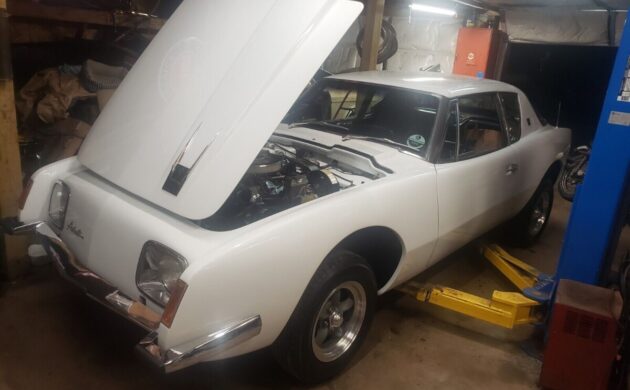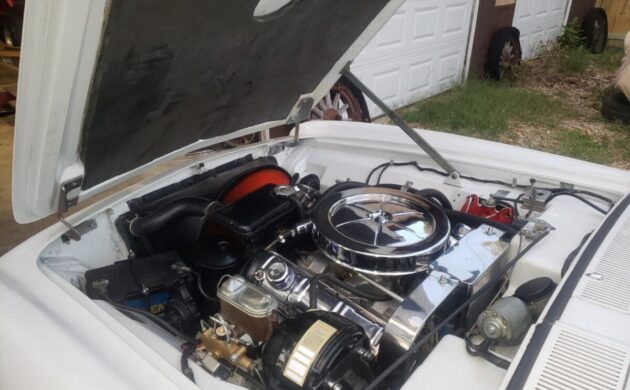When an automobile manufacturer is on its financial knees, the sensible strategy would be to release an affordable model which would sell in significant numbers to boost revenue. However, Studebaker wasn’t your average company. The fact we’re talking about the company in the past tense demonstrates that its decision to release the Avanti as a “halo” model to lure people into dealerships was unsuccessful. That’s a shame because the Avanti was an interesting vehicle with many positive points. Our feature car is a 1964 Avanti R1 that presents well following a recent restoration. It runs and drives well, opening the possibility of the winning bidder flying in and heading home behind the wheel of their new toy. It is listed here on eBay in Lincoln, Illinois. Bidding sits at $14,100, although that figure is below the reserve.
The Avanti was a groundbreaking vehicle within the personal luxury car segment. While the opposition continued using steel for their panels, Studebaker adopted fiberglass. That material offered weight advantages and was also immune from rust. The styling polarizes people, with Raymond Loewy’s design standing out from the crowd. That the Avanti soldiered on for decades with only minor styling changes suggests it received ready acceptance among those with the money to own one. This car carries loads of good news for potential buyers, courtesy of a previous professional restoration. Its Avanti White paint shines beautifully, and like the fiberglass panels, there are no visible flaws or defects. The alternate body material doesn’t mean these classics are immune from corrosion issues, but the seller states that prone areas like the frame and hog troughs are rock-solid. The chrome and glass look excellent for a vehicle of this vintage, and although the alloy wheels aren’t original, they perfectly suit the car’s character. For those seeking a more “factory” appearance, correct wheels and hubcaps appear on online auction sites regularly at affordable prices.
Turning our attention to this Avanti’s interior provides a pleasant surprise. The upholstered surfaces wear Black vinyl, which was probably installed during the restoration. The same appears true of the carpet because it doesn’t feature the distinctive color combination that owners received from the factory. It looks like there may be a slight tear on the outer edge of the driver’s seat, but that is the only visible fault. The rest of the interior presents nicely, from the dash and pad to the faux woodgrain trim and the beautiful gauge cluster. There are no aftermarket additions, but the Avanti features its original AM/FM radio and air conditioning the seller recently upgraded to R134 refrigerant. The only non-functioning features are the radio and clock.
Buyers could choose between two engines for their new Avanti, with the supercharged R2 unit providing impressive performance. This car features its numbers-matching R1 289ci V8, producing 240hp. The listing suggests the motor originally sent its power to a 3.54 Posi rear end via a four-speed T-10 manual transmission. However, the seller ditched the T-10, installing a five-speed in its place. This classic should cruise effortlessly at highway speeds with the luxury of an overdrive ratio. The motor may also pump out a few additional ponies thanks to the addition of an R2 camshaft and headers to improve breathing. The Avanti runs and drives well, and the seller’s willingness to entertain in-person inspections suggests they have nothing to hide.
Many enthusiasts will argue that the Avanti deserved a better fate than the one that befell it under the Studebaker umbrella. That it survived in limited production form for decades after Studebaker faded into a distant memory demonstrates that it experienced support within the community from those seeking a distinctive personal luxury car. This one looks like a beauty, but losing the original transmission will impact its potential sale price. Although values are climbing, recent results suggest it may struggle to top $30,000 before the auction ends. However, if it passes the reserve and sells for a lower figure, it could represent an excellent buy for the right person.





Nice car!
The better is always the enemy of the good says a parole.
That is exactly the case with this car. What the C2 Corvette
didn’t do (trunk lid), the Avanti did. Perhaps the masses were
not ready for this car because it can do many things better
than its competitors. Aside from the back then sheer numbers
of so called ‘muscle cars’.
Studebaker may have had the image of outdated, ‘grandparents’
cars but, like Nash, always built something special. Then they
met the same fate as Saab.
Good car. In my opinion the Avanti with 16″ rims and shorter shock absorbers states a more musculus and sporty appearance what
it should broadcast.
Huh?
It sure looks great, but I’m not thrilled with the theft recovery “rebuild” title. Is that the same as a salvage title in Illinois?
More importantly, is the original VIN plate still in place? I can see something on the passenger fenderwell in the right spot, but there’s no close-up shot offered.
Somebody school me ,is that Stud 289 ??
Yes, the R1 was a high performance 289.
60 years old? salvage/theft recovery title? Why nitpick? I think that stopped mattering a couple of decades ago. WYSIWYG. And it sure looks like a great start at a daily driver. I wish I could have it. The heavy lifting has been done.
As much as I’m not a fan of big wheels, this needs larger wheels and a drop, it would look much better. Drive and enjoy! I like it!
I liked the 1954-59 Studebakers, but I could never get over the “styling” of the Avanti, and even looking at it today I just can’t want to own one. Years ago, I assembled a metal kit 1957 Golden Hawk, which I really enjoyed. It is still on a shelf in my study and I look at that one with “would have liked to own one of those”. But Avanti… still just don’t get any feelings for that one.
“While the opposition continued using steel for their panels, Studebaker adopted fiberglass” ?
Chevrolet was using fiberglass on the Vettes from 1953 on , and the main reason Studebaker used it was because it was cheaper to produce and they didnt have the finances to make the dies for steel panels .
Again, as stated regarding the “Packardbaker” in this same listing, out-of-touch management decisions which ultimately led to their demise. IMO beautiful car and interior over obsolete mechanicals with a decent engine, all bespeaking a sad treatise.
what a treat – a Studi GH and Avanti on the same BF’s issue.
Ever C this one ina 4 door?